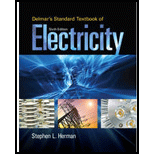
Mindtap Electrical, 4 Terms (24 Months) Printed Access Card For Herman's Delmar's Standard Textbook Of Electricity, 6th (mindtap Course List)
6th Edition
ISBN: 9781305634312
Author: Herman, Stephen L.
Publisher: Cengage Learning
expand_more
expand_more
format_list_bulleted
Concept explainers
Question
Chapter 14, Problem 10RQ
To determine
The electronic component that is used to prevent large voltage spikes from being produced when the current flow through an inductor is suddenly terminated.
Expert Solution & Answer
Trending nowThis is a popular solution!

Students have asked these similar questions
I need help with this problem and an explanation of the solution for the image described below. (Introduction to Signals and Systems)
Find Rth at the open terminals using 1V test source.
How many atoms are there in a simple cubic unit cell? in a bcc unit cell? in a fcc unit cell? in the
unit cell characterizing the diamond lattice?
Chapter 14 Solutions
Mindtap Electrical, 4 Terms (24 Months) Printed Access Card For Herman's Delmar's Standard Textbook Of Electricity, 6th (mindtap Course List)
Ch. 14 - What determines the polarity of magnetism when...Ch. 14 - What determines the strength of the magnetic field...Ch. 14 - 3. Name three factors that determine the amount of...Ch. 14 - 4. How many lines of magnetic flux must be cut in...Ch. 14 - Prob. 5RQCh. 14 - Into how many time constants is an exponential...Ch. 14 - 7. Each time constant of an exponential curve is...Ch. 14 - 8. An inductor has an inductance of 0.025 H and a...Ch. 14 - Refer to the circuit shown in Figure 14-21. Assume...Ch. 14 - Prob. 10RQ
Knowledge Booster
Learn more about
Need a deep-dive on the concept behind this application? Look no further. Learn more about this topic, electrical-engineering and related others by exploring similar questions and additional content below.Similar questions
- Consider the homogeneous RLC circuit (no voltage source) shown in the diagram below. Before the switch is closed, the capacitor has an initial charge go and the circuit has an initial current go- R 9(1) i(t)↓ After the switches closes, current flows through the circuit and the capacitor begins to discharge. The equation that describes the total voltage in the loop comes from Kirchoff's voltage law: L di(t) + Ri(t)+(0) = 0, (1) where i(t) and q(t) are the current and capacitor charge as a function of time, L is the inductance, R is the resistance, and C is the capacitance. Using the fact that the current equals the rate of change of the capacitor charge, and dividing by L, we can write the following homogeneous (no input source) differential equation for the charge on the capacitor: 4(1) +29(1)+w79(1)=0, ཀྱི where a= R 2L and The solution to this second order linear differential equation can be written as: 9(1) =Aent - Beat, where (3) (4) (5) A= (81+20)90 +90 (82+20)90 +90 and B= (6)…arrow_forwardConsider the homogeneous RLC circuit (no voltage source) shown in the diagram below. Before the switch is closed, the capacitor has an initial charge go and the circuit has an initial current go. R w i(t) q(t) C н After the switches closes, current flows through the circuit and the capacitor begins to discharge. The equation that describes the total voltage in the loop comes from Kirchoff's voltage law: di(t) L + Ri(t) + (t) = 0, dt (1) where i(t) and q(t) are the current and capacitor charge as a function of time, L is the inductance, R is the resistance, and C is the capacitance. Using the fact that the current equals the rate of change of the capacitor charge, and dividing by L, we can write the following homogeneous (no input source) differential equation for the charge on the capacitor: ä(t)+2ag(t)+wg(t) = 0, (2) where R a 2L and w₁ = C LC The solution to this second order linear differential equation can be written as: where 81= q(t) = Ae³¹- Bel 82 = (3) (4) (5)arrow_forwardI need help with this problem and an explanation of the solution for the image described below. (Introduction to Signals and Systems)arrow_forward
- please see fig 1 to solvearrow_forwardA particular battery charger produces a constant current of 2.4 amperes to charge a 3.7 volt Iphone battery. It can fully charge a dead battery to full charge in 6 hours. (a) How many electrons are in the charged battery? (b) What amount of energy in Joules does the battery provide if it deliveres 0.25 amperes of current to a phone for 4 hours.arrow_forwardplease see fig 2 to answerarrow_forward
arrow_back_ios
SEE MORE QUESTIONS
arrow_forward_ios
Recommended textbooks for you
 Delmar's Standard Textbook Of ElectricityElectrical EngineeringISBN:9781337900348Author:Stephen L. HermanPublisher:Cengage Learning
Delmar's Standard Textbook Of ElectricityElectrical EngineeringISBN:9781337900348Author:Stephen L. HermanPublisher:Cengage Learning Electricity for Refrigeration, Heating, and Air C...Mechanical EngineeringISBN:9781337399128Author:Russell E. SmithPublisher:Cengage Learning
Electricity for Refrigeration, Heating, and Air C...Mechanical EngineeringISBN:9781337399128Author:Russell E. SmithPublisher:Cengage Learning

Delmar's Standard Textbook Of Electricity
Electrical Engineering
ISBN:9781337900348
Author:Stephen L. Herman
Publisher:Cengage Learning

Electricity for Refrigeration, Heating, and Air C...
Mechanical Engineering
ISBN:9781337399128
Author:Russell E. Smith
Publisher:Cengage Learning